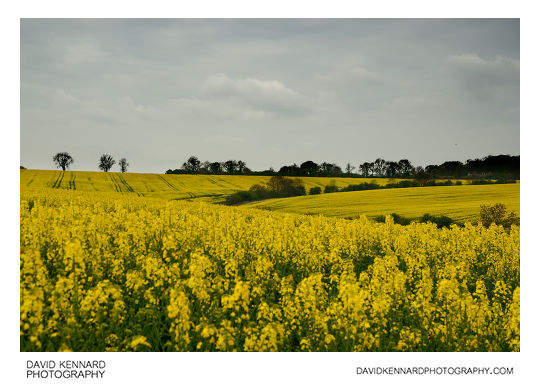Fields of oilseed rape - David Kennard Photography - England East Midland (sitios de interés)
Descripción del sitio

Fields of oilseed rape from http://www.davidkennardphotography.com
Rapeseed (Brassica napus), also known as rape, oilseed rape, rapa, rappi, rapaseed and (in the case of one particular group of cultivars, canola) is a bright yellow flowering member of the family Brassicaceae (mustard or cabbage family). The name derives from the Latin for turnip, r?pum or r?pa, and is first recorded in English at the end of the 14th century. Older writers usually distinguished the turnip and rape by the adjectives round and long(-rooted) respectively. See also Brassica napobrassica, which may be considered a variety of Brassica napus. Some botanists include the closely related Brassica campestris within B. napus. (See Triangle of U).
In agriculture, canola are certain varieties of rapeseed oil, or the oil produced from those varieties. Canola is a trademark for a hybrid variety of rape initially bred in Canada. Rapeseed oil was produced in the 19th century as a source of a lubricant for steam engines, and the oil has a bitter taste due to high levels of acids. Canola has been bred to reduce the amount of acid, yielding a more palatable oil.
Rapeseed is grown for the production of animal feed, vegetable oil for human consumption, and biodiesel; leading producers include the European Union, Canada, the United States, Australia, China and India. In India, it is grown on 13% of cropped land. According to the United States Department of Agriculture, rapeseed was the third leading source of vegetable oil in the world in 2000, after soybean and oil palm, and also the world's second leading source of protein meal, although only one-fifth of the production of the leading soybean meal.
World production is growing rapidly, with FAO reporting that 36 million tonnes of rapeseed was produced in the 2003-2004 season, and 46 million tonnes in 2004-2005. In Europe, rapeseed is primarily cultivated for animal feed, owing to its very high lipid and medium protein content, and is a leading option for Europeans to avoid importation of genetically modified organism (GMO) products.
Natural rapeseed oil contains 50% erucic acid. Wild type seeds also contain high levels of glucosinolates (mustard oil glucosindes), chemical compounds that significantly lowered the nutritional value of rape seed press cakes for animal feed. Canola, originally a syncopated form of the abbreviation "Can.O., L-A." (Canadian Oilseed, Low-Acid) that was used by the Manitoba government to label the seed during its experimental stages, is now a tradename for "double low" (low erucic acid and low glucosinolate) rapeseed. Sometimes the "Canola-quality" label is affixed to other varieties as well.
The rapeseed is the valuable, harvested component of the crop. The crop is also grown as a winter-cover crop. It provides good coverage of the soil in winter, and limits nitrogen run-off. The plant is ploughed back in the soil or used as bedding. On some ecological or organic operations, livestock such as sheep or cattle are allowed to graze on the plants.
Processing of rapeseed for oil production provides rapeseed animal meal as a by-product. The by-product is a high-protein animal feed, competitive with soya. The feed is mostly employed for cattle feeding, but also for pigs and chickens (though less valuable for these). The meal has a very low content of the glucosinolates responsible for metabolism disruption in cattle and pigs. Rapeseed "oil cake" is also used as a fertilizer in China, and may be used for ornamentals, such as Bonsai, as well.
Rapeseed leaves and stems are also edible, similar to those of the related bok choy or kale. Some varieties of rapeseed (called ??, yóu cài, lit. "oil vegetable" in Chinese; yau choy in Cantonese; c?i d?u in Vietnamese; phak kat kan khao [?????????????] in Thai; and nanohana [???] in Japanese) are sold as greens, primarily in Asian groceries, including those in California where it is known as yao choy or tender greens. They are eaten as sag (spinach) in Indian and Nepalese cuisine, usually stir-fried with salt, garlic and spices.
Rapeseed is a heavy nectar producer, and honeybees produce a light colored, but peppery honey from it. It must be extracted immediately after processing is finished, as it will quickly granulate in the honeycomb and will be impossible to extract. The honey is usually blended with milder honeys, if used for table use, or sold as bakery grade. Rapeseed growers contract with beekeepers for the pollination of the crop.
Description from Wikipedia: http://en.wikipedia.org/wiki/Brassica_napus
Date taken: 2010-05-05 10:55:14